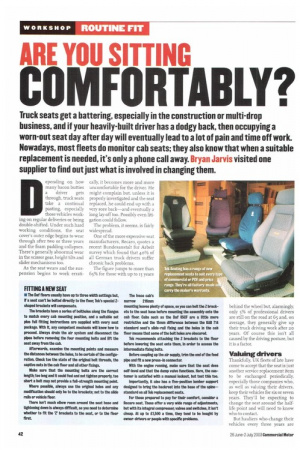ARE YOU SITTING
Page 42

Page 43

If you've noticed an error in this article please click here to report it so we can fix it.
COMFORTABLY?
Truck seats get a battering, especially in the construction or multi-drop business, and if your heavily-built driver has a dodgy back, then occupying a worn-out seat day after day will eventually lead to a lot of pain and time off work. Nowadays, most fleets do monitor cab seats; they also know that when a suitable replacement is needed, it's only a phone call away. Bryan Jarvis visited one supplier to find out just what is involved in changing them.
epending on how many bacon butlies a driver gets through, truck seats take a continual pasting, especially those vehicles working on regular deliveries or being double-shifted. Under such hard working conditions, the seat cover's outer edge begins to wear through after two or three years and the foam padding collapses. There's generally abnormal wear in the scissor gear, height tilts and slider mechanisms too.
As the seat wears and the suspension begins to work errati cally, it becomes more and more uncomfortable for the driver. He might complain but, unless it is properly investigated and the seat replaced, he could end up with a very sore back—and eventually a long lay-off too. Possibly even litigation could follow.
The problem, it seems, is fairly widespread.
One of the more expensive seat manufacturers, Recaro, quotes a recent Bundesanstalt fur Arbeit survey which found that 40% of all German truck drivers suffer chronic back problems.
The figure jumps to more than 65% for those with up to 15 years
behind the wheel but, alarmingly, only 5% of professional drivers are still on the road at 65 and, on average, they generally give up their truck driving work after 20 years. Of course this isn't all caused by the driving posture, but it is a factor.
Valuing drivers
Thankfully, UK fleets of late have come to accept that the seat is just another service replacement item to be exchanged periodically, especially those companies who, as well as valuing their drivers, keep their vehicles for six or seven years. They'll be expecting to change the seat around the halflife point and will need to know who to contact.
But hauliers who change their vehicles every three years are unlikely to replace any of its seats, so the problem belongs to the next owner.
Many local repairers dabble in the re-covering business, but Tek Seating is one of the few established firms that specialises in supplying new replacements across the full range of CV, PCV, construction and plant sectors.
Normally it stocks a range of Isringhausen, KAB (formerly Bostrum), Grammer and Recaro seats, all supplied new from their factories.
The cheaper ones retail at about k5o, those with integral seatbelts cost around 155o, while very high-spec electronic, ventilated seats are a lot more. It sounds expensive, but it's far cheaper than ordering them direct from the truck builder.
Most comfort
scania, for example, charges four figures for an original 4-Series seat, but Tek's R714B which is claimed to be quite a suitable replacement, costs around koo. The seat has an identical mounting footprint, is belted, has self-levelling air suspension. Its height and tilt changes are done mechanically, not electronically, but the ride characteristics and adjustments are said to be very similar.
Most of Tek's clients follow a 'most comfort for the least price' mantra, but if an owner-driver wants an OE seat or something slightly off-beam, Tek will supply.
But, as we discovered on a
recent visit, replacing truck seats is relatively straightforward as their 3 o5mm (left to right) and 28 OMM (front to rear) footprints are fairly common. Good preparation should keep the job time down to around two hours.
To show what's involved with replacing two basic air-suspended seats, Tek arranged to have two customer vehicles on hand; one a non-belted Daf 85CF artic belonging to R Swain & Sons, the other a more recent X-reg Daf 95-series with integral seat belt out of the HE Services fleet at Rochester.




































































































































































